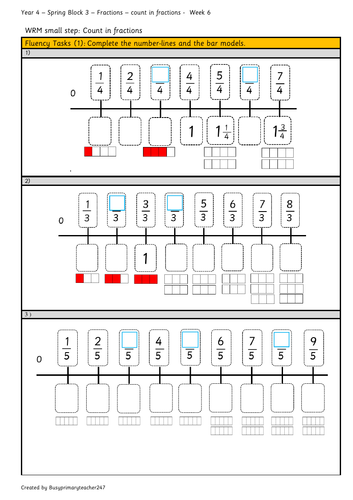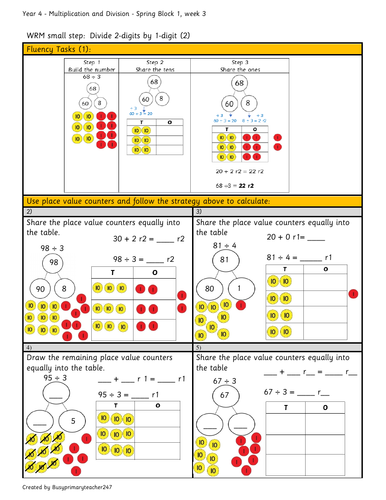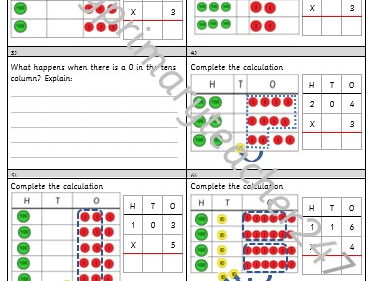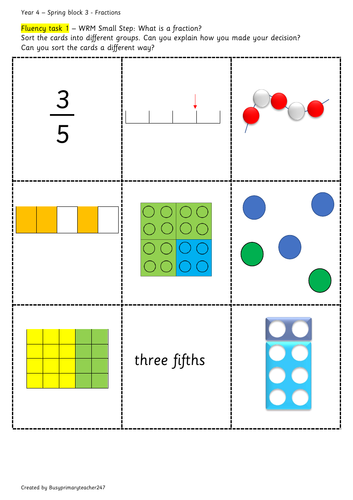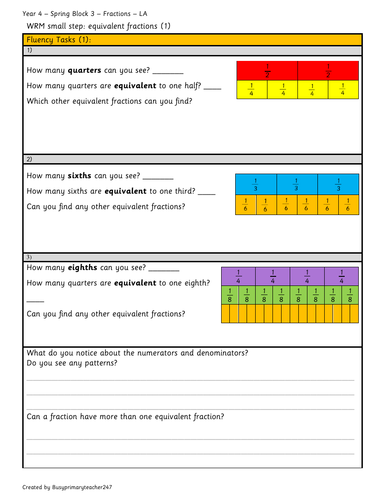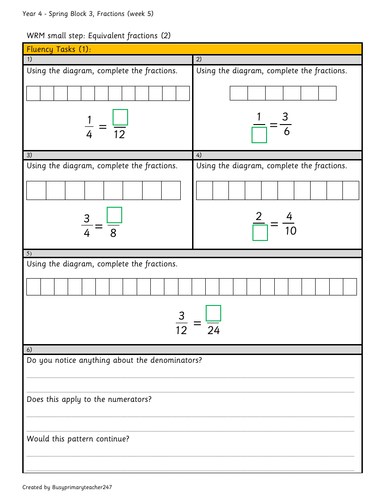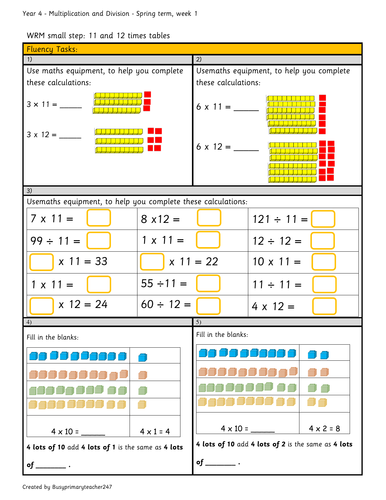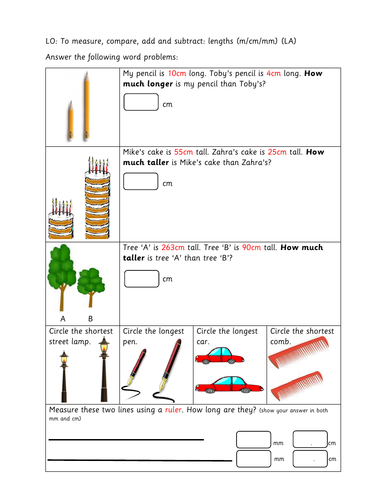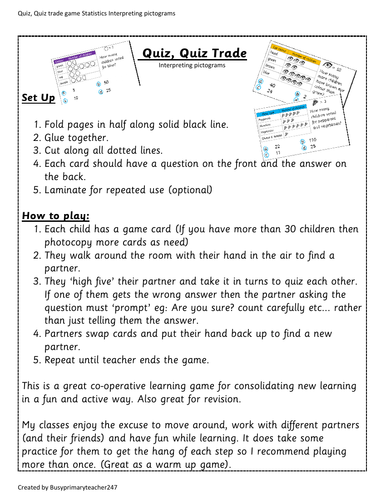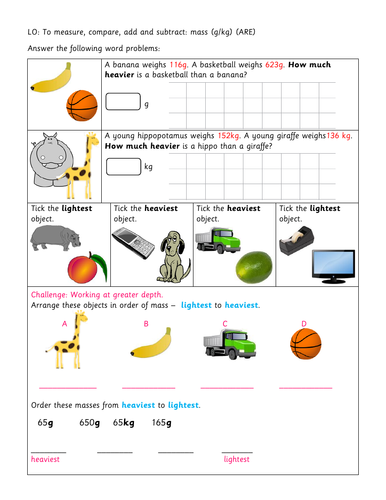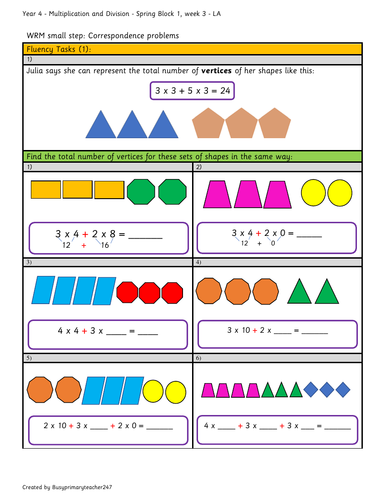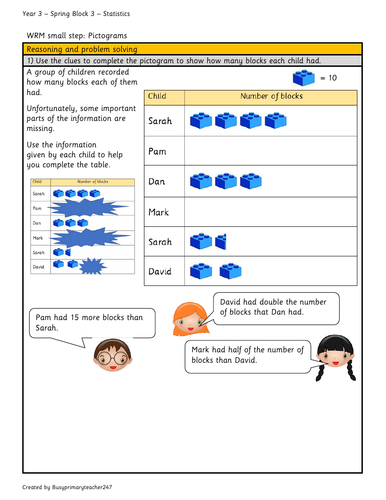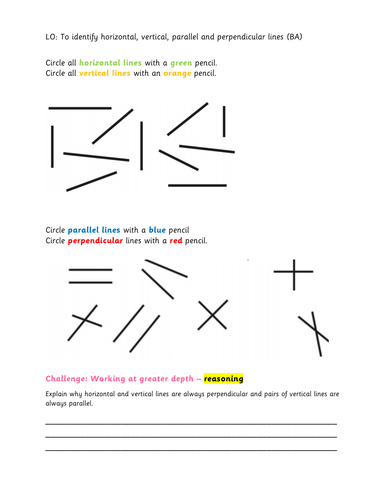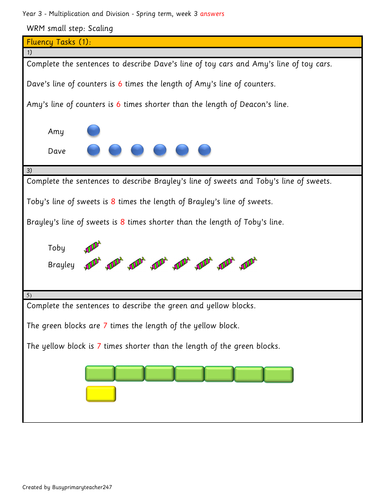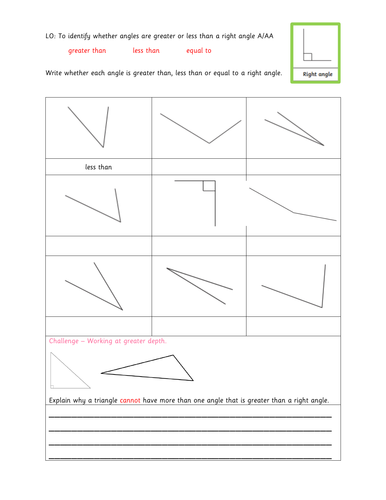132Uploads
175k+Views
66k+Downloads
Mathematics

Year 4 – Spring Block 3 – Fractions - week 6 - Count in fractions
This resource follows the concrete-pictorial-abstract approach to Maths Mastery and also includes reasoning questions. It is differentiated two ways and linked to WRM small step: Count in fractions.
Curriculum links:
- Recognise and show, using diagrams, families of common equivalent fractions.
I hope you find this resource useful,
Your feedback is always welcome :)

Year 4 - Spring block 1 - Divide 2-digits by 1-digit (2) week 3
This resource links to Year 4, Spring, block 1(week 3) small step 'Divide 2-digits by 1-digit (2)'
The contents include differentiated worksheets (and answers) that follow the concrete, pictorial and abstract method for maths mastery. They also include reasoning and problem-solving.
Curriculum links:
- Recall and use multiplication and division facts for multiplication tables up to 12 ×12.
- Use place value, known and derived facts to multiply and divide mentally, including multiplying by 0 and 1; dividing by 1; multiplying together three numbers.
- Recognise and use factor pairs and commutativity in mental calculations.
-Solve problems involving multiplying and adding, including using the distributive law to multiply two digit numbers by one digit, integer scaling
problems and harder correspondence problems such as n objects are connected to m objects.
I hope you find these useful,
Your feedback is always welcome x

Year 4 - Multiply 3-digits by 1-digit
This resource links to Year 4, Spring, block 1 Multiplication, and Division and small step 'Multiply 3-digit by 1-digit numbers'.
The contents include differentiated worksheets (and answers) that follow the concrete, pictorial and abstract method for maths mastery. They also include reasoning and problem-solving.
Curriculum links:
- Recall and use multiplication and division facts for multiplication tables up to 12 ×12.
- Use place value, known and derived facts to multiply and divide mentally, including: multiplying by 0 and 1; dividing by 1; multiplying together three numbers.
- Recognise and use factor pairs and commutativity in mental calculations.
I hope you find these useful,
Your feedback is always welcome x

Year 4 – Spring Block 3 – Fractions - What is a fraction?
This resources follows the concrete-pictorial-abstract approach to Maths Mastery and also includes reasoning questions. It is differentiated two ways and linked to WRM small step: What is a fraction?
Curriculum links:
- Recognise and show, using diagrams, families of common equivalent fractions.
I hope you find this resource useful,
Your feedback is always welcome :)

Year 4 – Spring Block 3 – Fractions - week 5 - Equivalent Fractions (1)
This resource follows the concrete-pictorial-abstract approach to Maths Mastery and also includes reasoning questions. It is differentiated two ways and is linked to WRM small steps: Equivalent fractions (1)
Curriculum links:
- Recognise and show, using diagrams, families of common equivalent fractions.
I hope you find this resource useful,
Your feedback is always welcome :)

Year 4 – Spring Block 3 – Fractions - week 5 - Equivalent fractions (2)
These resources follow the concrete-pictorial-abstract approach to Maths Mastery and also include reasoning questions. They are differentiated two ways and is linked to WRM small step: Equivalent fractions (2)
Curriculum links:
- Recognise and show, using diagrams, families of common equivalent fractions.
I hope you find this resource useful,
Your feedback is always welcome :)

Year 4 multiplication (C-P-A)- Australian Curriculum linked
These resources follow the Math mastery approach of using concrete-pictorial-abstract models. They are differentiated and the answer sheets are included (you're welcome).
Links to the new Australian Curriculum - Year 4 -
-Apply place value to partition, rearrange and regroup numbers to at least tens of thousands to assist calculations and solve problems (ACMNA073)
- Investigate number sequences involving multiples of 3, 4, 6, 7, 8, and 9 (ACMNA074)
-Recall multiplication facts up to 10 × 10 and related division facts (ACMNA075)
- Develop efficient mental and written strategies and use appropriate digital technologies for multiplication and for division where there is no remainder (ACMNA076)

Year 1 Counting in 2s
This resource contains varied fluency worksheets that allow children to practise the skill of counting in 2s using concrete, pictorial and abstract methods. Also included, are reasoning and problem-solving questions, and answer sheets.
WRM links: Year 1 Spring Block 2, Number, Place Value, Numbers within 50 (week 7)
Small Step: Count in 2s
Curriculum Links
• Count to 50 forwards and backwards, beginning with 0 or 1, or from any number.
• Count, read and write numbers to 50 in numerals.
• Given a number, identify one more or one less.
• Identify and represent numbers using objects and pictorial representations including the number line, and use the language of: equal to, more than, less than (fewer), most, least.
• Count in multiples of twos, fives and tens.
I hope you find this resource useful.
Enjoy x

Year 1 Counting in 5s
This resource contains varied fluency worksheets that allow children to practise the skill of counting in 5s using concrete, pictorial and abstract methods. Also included, are reasoning and problem-solving questions, and answer sheets.
WRM links: Year 1 Spring Block 2, Number, Place Value, Numbers within 50 (week 7)
Small Step: Count in 5s
Curriculum Links
• Count to 50 forwards and backwards, beginning with 0 or 1, or from any number.
• Count, read and write numbers to 50 in numerals.
• Given a number, identify one more or one less.
• Identify and represent numbers using objects and pictorial representations including the number line, and use the language of: equal to, more than, less than (fewer), most, least.
• Count in multiples of twos, fives and tens.
I hope you find this resource useful.
Enjoy x

Year 3 - differentiated worksheets - length
Here are 2 differentiated worksheets based on the length of objects. It includes addition, subtraction, multiplication (integer scaling) and reasoning questions.
Curriculum links:
-Measure, compare, add and subtract: length (mm/cm/m/km)
-Compare the length of objects using mixed units (mm/cm/m/km)
-Compare the length of objects using simple scaling by integers.
I hope you find this resource useful.
Your feedback is always welcome x

Quiz, Quiz Trade activity cards - Interpreting pictograms
This is a great co-operative learning game for consolidating new learning in a fun and active way. Also great for revision.
My classes enjoy the excuse to move around, work with different partners (and their friends) and have fun while learning. It does take some practice for them to get the hang of each step so I recommend playing more than once. (Great as a warm up game).

Year 3 - differentiated worksheets - Mass
Here are 2 differentiated worksheets based on the weight of objects. It includes addition, subtraction, multiplication (integer scaling) and reasoning questions.
Curriculum links:
-Measure, compare, add and subtract: mass (g/kg)
-Compare the mass of objects using mixed units (g/kg)
-Compare the weight of objects using simple scaling by integers.
I hope you find this resource useful.
Your feedback is always welcome x

Year 4 - Spring Block 1 - Correspondence Problems (week 3) UK and AU Curriculum Linked
This resource links to Spring Block 1 (week 3) Small step - Correspondence Problems.
This pack contains differentiated worksheets (and answers) that follow the concrete, pictorial and abstract method for maths mastery. They also include reasoning and problem-solving.
Curriculum links for UK:
- Recall and use multiplication and division facts for multiplication tables up to 12 ×12.
- Use place value, known and derived facts to multiply and divide mentally, including multiplying by 0 and 1; dividing by 1; multiplying together three numbers.
- Recognise and use factor pairs and commutativity in mental calculations.
-Solve problems involving multiplying and adding, including using the
distributive law to multiply two digit numbers by one digit, integer scaling
problems and harder correspondence problems such as n objects are connected to m objects.
Australian Curriculum links:
-Represent and solve problems involving multiplication using efficient mental and written strategies and appropriate digital technologies (ACMNA057)
-Recall multiplication facts of two, three, five and ten and related division facts (ACMNA056)
Achievement Standards:
- Understanding includes connecting names, numerals, and quantities.
- Fluency includes readily counting numbers in sequences, continuing patterns and comparing the lengths of objects.
- Problem-solving includes using materials to model authentic problems, sorting objects, using familiar counting sequences to solve unfamiliar problems and discussing the reasonableness of the answer.
- Reasoning includes explaining comparisons of quantities, creating patterns and explaining processes for indirect comparison of length.
I hope you find these useful,
Your feedback is always welcome x

Year 3 Question strips linked to block 3 - Multiplication and Division (Autumn Week 9)
A set of 5 questions strips based on a maths mastery approach (concrete - pictorial - abstract) for Multiplication and Division (Autumn term, week 9).
Links to:
Year 3 National curriculum objectives:
- Recall and use multiplication and division facts for the 3, 4 and 8 multiplication tables.
- Write and calculate mathematical statements for multiplication and division using the multiplication tables they know, including for two-digit numbers times one-digit numbers, using mental and progressing to formal written methods.
- Solve problems, including missing number problems, involving multiplication and division, including positive integer scaling problems and correspondence problems in which 'n' objects are connected to 'm' objectives.
Enjoy!
Your feedback is always welcome x

Place Value - Ordering Numbers Within 50
This resource links with Year 1, Spring Block 2, Number: Place Value (within 50) and uses a concrete - pictorial -abstract method to support the teaching of ordering numbers within 50. It also includes answers.
Curriculum Links
-Count to 50 forwards and backwards, beginning with 0 or 1, or from any number.
-Count, read and write numbers to 50 in numerals.
-Identify and represent numbers using objects and pictorial representations including the number line, and use the language
of: equal to, more than, less than (fewer), most, least.
I hope you find this resource useful x

Year 3 - interpreting pictograms (2)
This resources enables children to read and interpret information from pictograms, make comparisons and ask questions about data. It includes worksheets linked to WRM fluency tasks 1 & 2 and reasoning questions.
WRM Small Step: pictograms
Curriculum links:
-Interpret and present data using bar charts, pictograms and tables.
-Solve one-step and two-step questions [for example, ‘How many more?’ and ‘How many fewer?’ using information presented in scaled bar charts and pictograms and tables.
Enjoy!
Your feedback is always welcome x

Year 3 - Identifying horizontal, vertical, parallel and perpendicular lines
Worksheet / assessment focusing on identifying horizontal, vertical, parallel and perpendicular lines. Differentiated BA and A AA (Includes Greater depth question)
Links with Year 3 National Curriculum and Rising Stars objectives.

Year 3 - Spring block 1 - Scaling (week 3)
This set of resources follows the concrete-pictorial-abstract method of WRM and Maths Mastery. It contains fluency, reasoning, and problem-solving tasks linked to WRM small step - Scaling (week 3)
The worksheets are differentiated between lower ability and age-related and the answers are included :)
UK National curriculum links:
-Recall and use multiplication and division facts for the 3, 4 and 8 multiplication tables.
-Write and calculate mathematical statements for multiplication and division using the multiplication tables they know, including for two-digit numbers times one-digit numbers, using mental and progressing to formal written methods.
-Solve problems, including missing number problems, involving multiplication and division, including positive integer scaling problems and correspondence problems in which n objects are connected to m objectives.
Australian Curriculum (V8.3)
-Apply place value to partition, rearrange and regroup numbers to at least 10 000 to assist calculations and solve problems (ACMNA053)
-Recall multiplication facts of two, three, five and ten and related division facts (ACMNA056)
-Represent and solve problems involving multiplication using efficient mental and written strategies and appropriate digital technologies (ACMNA057)
-fluency includes recalling multiplication facts, using familiar metric units to order and compare objects, identifying and describing outcomes of chance experiments, interpreting maps and communicating positions.
-problem-solving includes formulating and modelling authentic situations involving planning methods of data collection and representation, making models of three-dimensional objects and using number properties to continue number patterns
- reasoning includes using generalising from number properties and results of calculations, comparing angles and creating and interpreting variations in the results of data collections and data displays.
I hope you find these resources helpful!
Your feedback is always welcome x

Year 3 - differentiated worksheets - Capacity
Here are 2 differentiated worksheets based on the capacity of objects. It includes addition, subtraction, multiplication (integer scaling) and reasoning questions.
Curriculum links:
-Measure, compare, add and subtract: Capacity (ml/l)
-Compare the capacity of objects using mixed units (ml/l)
-Compare the capacity of objects using simple scaling by integers.
I hope you find this resource useful.
Your feedback is always welcome x

Year 3 - Greater than less than a right angle differentiated assessment
Worksheet / assessment focusing on angles being greater than or less than a right angle. Differentiated into BA and A/AA (Includes greater depth question)
Links to Rising Stars Objectives: Identify angles greater than or less than a right angle.

